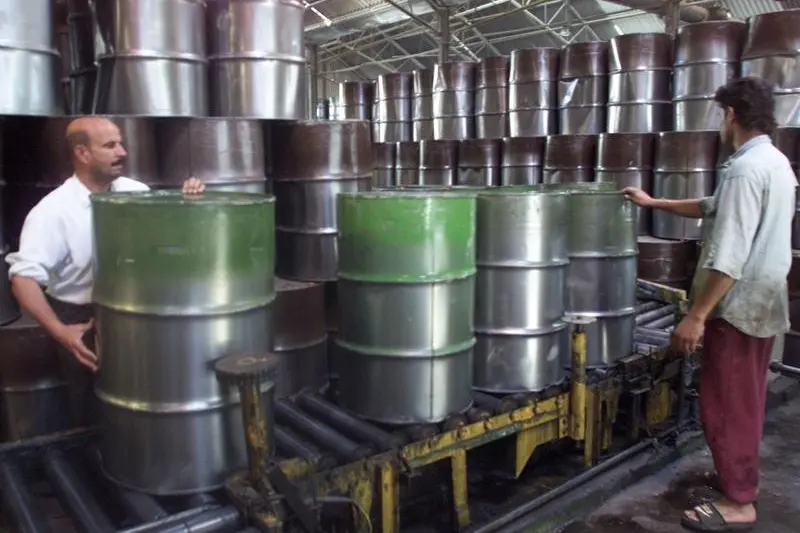PHOTO
Oil prices have retreated in recent weeks as traders look past the current depletion in global inventories to focus on the future threat posed by a possible slowdown in the major economies.
Commercial stocks of crude and refined products in the advanced economies belonging to the Organization for Economic Cooperation and Development (OECD) amounted to 2,761 million barrels at the end of June.
Stocks were 120 million barrels (-4% or -0.71 standard deviations) below the ten-year seasonal average and the deficit had widened from 74 million (-3% or -0.47 standard deviations) at the end of March.
The deficit was the widest for almost two years since September 2022, according to data from the Short-Term Energy Outlook prepared by the U.S. Energy Information Administration (EIA).
Front-month Brent futures prices and the six-month calendar spread both weakened slightly over the second quarter, but were still above the long-term inflation adjusted average, consistent with a gradually tightening market.
CONTINUED THIRD QUARTER DEPLETION
Since the end of June, U.S. commercial crude inventories, the most frequently and rapidly reported stocks in global markets, have continued to decline further and faster than usual, adding to evidence of a tightening market.
U.S. crude inventories declined in each of the five weeks since the end of June by a total of 19 million barrels, according to the EIA's Weekly Petroleum Status Report.
U.S. crude inventories typically decline over July and August as refineries ramp up processing to meet elevated demand for gasoline during the summer vacation period.
But the seasonal depletion this year was the largest since 2019, and among the largest in the last decade, indicating that global supplies likely continued to tighten at the start of the third quarter.
U.S. crude inventories were 11 million barrels (-3% or -0.23 standard deviations) below the ten-year average on August 2 and the deficit had widened from 4 million (-1% or -0.08 standard deviations) at the end of June.
Chartbook: Global oil inventories and prices
Most of the depletion occurred at refineries and tank farms in Texas and Louisiana along the Gulf of Mexico, the most closely integrated with global oil markets.
Crude inventories on the Gulf Coast declined in each of the five weeks since the end of June by a total of 19 million barrels, compared with an average depletion of 6 million over the previous decade.
Regional stocks were still 5 million barrels (+2% or +0.17 standard deviations) above the 10-year average on Aug. 2 but the surplus had narrowed from 18 million (+8% or +0.59 standard deviations) five weeks previously.
DETERIORATING ECONOMIC OUTLOOK
Notwithstanding the inventory depletion, hedge funds and other money managers have become increasingly bearish about the outlook for petroleum prices.
Fund managers cut their combined position in the six most important petroleum futures and options contracts to just 262 million barrels (4th percentile for all weeks since 2013) on July 30.
The combined position had been reduced from 524 million barrels (40th percentile) at the end of June and 616 million (58th percentile) at the end of March.
One reason is that portfolio investors have reacted negatively to plans by OPEC⁺ to unwind some of the group's production cuts from the start of the fourth quarter.
But the primary concern seems to be the deteriorating outlook for the global economy and petroleum consumption.
Purchasing managers surveys and freight data have shown the first-quarter rebound in manufacturing ran out of momentum in the second and third quarters.
From mid-July and especially the start of August concerns about the outlook have become more pronounced, causing oil prices to slump to the lowest level since the start of the year.
Front-month Brent prices have averaged $77 per barrel so far in August, putting them in only the 40th percentile for all months since the turn of the century, after allowing for inflation.
Current prices and positions are consistent with a broad economic deceleration, a mid-cycle slowdown if not a full-blown recession, dampening petroleum consumption and halting or reversing the depletion of inventories.
If the slowdown fails to materialise, however, and depletion continues, prices are primed for a rebound - with the rally anticipated, accelerated and amplified by fund managers rebuilding their positions.
Lower prices are already curbing output growth from U.S. shale producers and will amplify the price rebound, as well as OPEC's ability to unwind some production cuts - but only if the economy avoids a slowdown.
John Kemp is a Reuters market analyst. The views expressed are his own
(Editing by David Evans)























